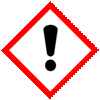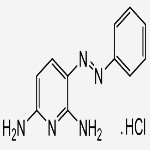CAS Number 136-40-3, Phenazopyridine Hydrochloride or Phenazopyridine HCl USP Grade Manufacturers Exporters







CAS Number 136-40-3, Phenazopyridine Hydrochloride or Phenazopyridine HCl USP Manufacturer Exporter
For Properties Specifications of Phenazopyridine Hydrochloride or Phenazopyridine HCl Click Properties, Specifications of Phenazopyridine Hydrochloride or Phenazopyridine HCl Manufacturer.
For Uses of Phenazopyridine Hydrochloride or Phenazopyridine HCl Click Uses of Phenazopyridine Hydrochloride or Phenazopyridine HCl Manufacturer.
For For SDS MSDS Sheet of Phenazopyridine Hydrochloride or Phenazopyridine HCl Click SDS Safety Data Sheet MSDS Sheet of Phenazopyridine Hydrochloride or Phenazopyridine HCl Manufacturer.
The Properties and Specifications of Phenazopyridine Hydrochloride or Phenazopyridine HCl:
Phenazopyridine Hydrochloride USP Grade Specifications:
C11H11N5-HCl --- 249.70
2,6-Pyridinediamine, 3-(phenylazo)-, monohydrochloride;
2,6-Diamino-3-(phenylazo)pyridine monohydrochloride CAS 136-40-3
UNII: 0EWG668W17
UNII: K2J09EMJ52
DEFINITION
Phenazopyridine Hydrochloride contains NLT 99.0% and NMT 101.0% of phenazopyridine hydrochloride (C11H11N5-HCl), calculated on the dried basis.
IDENTIFICATION
A. Infrared Absorption.
B. Ultraviolet Absorption.
Medium: Sulfuric acid in alcohol (1 in 360)
Sample solution: 5 µg/mL
Acceptance criteria: Meets the requirements
C. Passes the chromatographic test.
Residue on Ignition: NMT 0.2%
Water-Insoluble Substances:
Sample: 2 g
Analysis: Dissolve the Sample in 200 mL of water, heat to boiling, then heat in a covered container on a steam bath for 1 h. Filter through a tared, fine-porosity, sintered-glass crucible, wash thoroughly with water, and dry at 105C to constant weight.
Acceptance criteria: The weight of the residue does not exceed 0.1% of the weight of Phenazopyridine Hydrochloride taken.
Ordinary Impurities: To pass the test.
Loss on Drying: Dry at 105C for 4 h. Acceptance criteria: NMT 1.0%
The Uses of Phenazopyridine Hydrochloride or Phenazopyridine HCl:
Phenazopyridine Hydrochloride or Pyripyridium or Urodine or Phenazopyridine HCl is used to relieve symptoms caused by irritation of the urinary tract such as pain, burning, and the feeling of needing to urinate urgently or often.
The MSDS-SDS Hazard Statement of Phenazopyridine Hydrochloride or Phenazopyridine HCl:
Phenazopyridine Hydrochloride or Pyripyridium or Urodine or Phenazopyridine HCl SDS GHS, Safety Data Sheet
MSDS Sheet, Material Safety Data Sheet 12-Nov-24
1. Product Identification
Product Name & Other Names: Phenazopyridine Hydrochloride or Pyripyridium or Urodine or Phenazopyridine HCl.
CAS No.: 136-40-3
EINECS EC Number: 205-243-8
Relevant uses and uses advised against (if any): Industrial use only.
Supplier: As per letterhead.
2. Hazards Identification
GHS, Globally Harmonized System Classification in accordance with 29 CFR 1910
Classification according to Regulation (EC) No 1272/2008
Acute toxicity, oral (Category 4)
Skin irritation (Category 2)
Eye irritation (Category 2A)
Carcinogenicity (Category 2)
Specific target organ toxicity - single exposure (Category 3), Respiratory system
Labeling according to GHS & Regulation (EC) No 1272/2008
GHS Label Elements  Irritant |
GHS Label Elements |
Signal Words: Warning
Hazard Statements:
H302: Harmful if swallowed.
H315: Causes Skin Irritation.
H319: Causes serious eye irritation.
H335: May cause respiratory irritation
H351: Suspected of causing cancer.
Precautionary Statements:
P202: Do not handle until all safety precautions have been read and understood.
P260: Do not breathe dust/fume/gas/mist/vapors/spray.
P270: Do not eat, drink or smoke when using this product.
P280: Wear protective gloves/protective clothing/eye protection/face protection.
P281: Use personal protective equipment as required.
P301+P312: IF SWALLOWED: Call a POISON CENTER or doctor/ physician if you feel unwell.
P302+P352: IF ON SKIN: Wash with plenty of soap and water.
P305+P351+P338: IF IN EYES: Rinse cautiously with water for several minutes. Remove contact lenses, if present and easy to do. Continue rinsing.
P308+313: IF exposed or concerned: Get medical advice/attention.
P332+P313: If skin irritation occurs: Get medical advice/attention.
P405: Store locked up.
3. Composition/Information on Ingredients
Product Name & Other Names: Phenazopyridine Hydrochloride or Pyripyridium or Urodine or Phenazopyridine HCl.
CAS No.: 136-40-3
4. First Aid Measures
Always seek medical attention after first aid measures are provided.
Inhalation: Remove to fresh air. If not breathing, give artificial respiration. If breathing is difficult, give oxygen. Get medical attention.
Ingestion: Never give anything by mouth to an unconscious person. Get medical attention.
Skin Contact: Wipe off excess material from skin then immediately flush skin with plenty of water for at least 15 minutes. Remove contaminated clothing and shoes. Get medical attention. Wash clothing before reuse.
Eye Contact: Immediately flush eyes with plenty of water for at least 15 minutes, lifting lower and upper eyelids occasionally. Get medical attention immediately.
5. Fire Fighting Measures
Flammability of the Product: May be combustible at high temperature.
Products of Combustion: Carbon dioxide, Carbon monoxide, Nitrogen oxides, Chlorine compounds and fumes.
Explosion: Slightly explosive in presence of heat.
Fire Extinguishing Media: Use any means suitable for extinguishing surrounding fire. Use water spray, alcohol-resistant foam, dry chemical, or carbon dioxide. Avoid solid water jet as it can scatter the fire.
Special Information: In the event of a fire, wear full protective clothing and NIOSH-approved self-contained breathing apparatus with full face piece operated in the pressure demand or other positive pressure mode.
6. Accidental Release Measures
Personal precautions, protective equipment, and emergency procedures: Ventilate area of leak or spill. Avoid breathing dust/fumes/gas/mist/vapors/spray. Use individual protective equipment (waterproof boots, suitable protective clothing, safety glasses, etc.). Restrict unprotected personnel from the area.
Environmental precautions: Do not let the product enter drains, soil, or water sources.
Methods and materials used for containment cleanup procedures and Storage:
Small Spill: Avoid dust formation. Avoid breathing dust. Ensure adequate ventilation. Use appropriate tools to put the spilled solid in a convenient waste disposal container.
Large Spill: Avoid touching the spilled material. Contain spilled material. Cover with an inert, non-combustible absorbent material, (e.g., sand, earth, diatomaceous earth, vermiculite). Vacuum or sweep-up and remove to an approved disposal container.
7. Handling and Storage
Precautions for safe handling: Apply according to good manufacturing and industrial hygiene practices. Ensure proper ventilation. In case of insufficient ventilation, wear suitable respiratory equipment. Wash thoroughly after handling. Do not drink, eat, or smoke while handling. Avoid contact with skin, eyes, and clothing. Minimize dust generation. Avoid breathing dust/fumes/gas/mist/vapors/spray. Keep container tightly closed. Avoid ingestion and inhalation. Use individual protective equipment (waterproof boots, suitable protective clothing, safety glasses, etc.).
Conditions for safe storage, including any incompatibilities: Store in cool, dry, and ventilated area away from heat sources and protected from sunlight in tightly closed original container. Keep air contact to a minimum. Store protected from heat, sparks and ignition sources and incompatible materials. Avoid inhalation of dust/mist/vapor. Do not store with incompatible materials like strong oxidizing agents. Storage: Refrigerate. 2C to 8C.
8. Exposure Controls/Personal Protection
Airborne Exposure Limits: Not established.
Ventilation System: A system of local and/or general exhaust is recommended to keep employee exposures as low as possible.
Personal Respirators (NIOSH Approved): For conditions of use where exposure to dust or mist is apparent and engineering controls are not feasible, a particulate respirator may be worn.
Skin Protection: Wear protective gloves and clean body-covering clothing.
Eye Protection: Use chemical safety goggles and/or full-face shield where dusting or splashing of solutions is possible. Maintain eye wash fountain and quick-drench facilities in work area.
Other Control Measures: Maintain good housekeeping in work area. Handle in accordance with good industrial hygiene and safety practice.
9. Physical and Chemical Properties
Appearance: Purple to brick-red powder.
Odor: No data found.
Odor threshold: No data found.
pH: No data found.
Relative density: No data found.
Boiling Point: No data found.
Melting Point: No data found.
Flash point: No data found.
Auto-ignition temperature: No data found.
Decomposition temperature: No data found.
Upper/lower flammability or explosive limits: No data found.
Vapor pressure: No data found.
Vapor density: No data found.
Evaporation rate: No data found.
Flammability (solid, gas): No data found.
Partition coefficient: n-octanol/water: No data found.
Solubility: Soluble in Cold Water. Soluble in Methanol.
Viscosity: No data found.
10. Stability and Reactivity
Stability: Stable under ordinary conditions of use and storage.
Hazardous Decomposition Products: It emits Carbon dioxide, Carbon monoxide, Nitrogen oxides, Chlorine compounds & Fumes.
Hazardous Polymerization: Will not occur.
Incompatibilities: Strong oxidizing agents.
Conditions to Avoid: Incompatibles.
11. Toxicological Information
Toxicity data: ORL-RAT LD50: 472 mg kg-1
Carcinogenic Effects: Classified 2B (Possible for human.) by IARC. Classified 2 (Some evidence.) by NTP. May cause cancer.
Mutagenic Effects: No data found.
Teratogenic Effects: No data found.
Developmental Toxicity: No data found.
12. Ecological Information
Toxicity data: No data found.
Results of PBT and vPvB assessment: This substance/mixture contains no components considered to be either persistent, bioaccumulative and toxic (PBT), or very persistent and very bioaccumulative (vPvB) at levels of 0.1% or higher.
13. Disposal Considerations
Whatever cannot be saved for recovery or recycling should be managed in an appropriate and approved waste disposal facility. Follow all the pollution control rules.
14. Transport Information
USA DOT, ADR/RID Europe & Canada TDG: Not dangerous goods.
IATA: Not dangerous goods.
15. Regulatory Information
USA:
SARA 311/312 Hazards: See section 2.
Section 16 - Additional Information
DISCLAIMER: The information and recommendations set forth herein are presented in good faith and believed correct as of the date hereof. It is compiled from various sources, and it is not necessarily all inclusive nor fully adequate in every circumstance. In addition, these suggestions should not be confused with nor followed in violation of applicable laws, regulations, rules, or insurance requirements applicable. This MSDS sheet is intended only as a guide to the appropriate precautionary handling of the material by a professionally trained person using this product. Individuals receiving the information must exercise their judgment in determining its appropriateness for a purpose.
Anmol Chemicals & Pharmaceuticals Pvt. Ltd. is an off-shoot of Anmol Chemicals Taloja. It is located in MIDC Taloja and it is manufacturing pharmaceutical grades of API, Excepients, Food grade and Reagent grade chemicals. Anmol Chemicals & Pharmaceuticals Pvt. Ltd. is a several decades old group of companies, engaged in manufacturing, supplying, distributing, wholesale supplies for actual users, retail or small pack supplies for research and development chemicals, fine and speciality chemicals, pharmaceutical excipients, mineral fortifiers in chemically pure, Analytical reagent grade, IP BP USP Ph Eur EP JP and other pharmaceutical grade monograph including FCC Food grade chemicals and Nutraceuticals, Mineral Fortifiers at best prices.

Phenazopyridine Hydrochloride or Phenazopyridine HCl Structure
CAS Number 136-40-3, Phenazopyridine Hydrochloride or Phenazopyridine HCl Manufacturer Exporter
ANMOL CHEMICALS & PHARMACEUTICALS Pvt. Ltd.
India, USA, Europe, UAE
TELEPHONE: +912223770100
Navi Mumbai, INDIA
e-mail: info(At the rate i.e. @)anmol.org
Copyright. 3-may-25
We manufacture:
Chlorhexidine Hydrochloride or Chlorhexidine Dihydrochloride or Chlorhexidine
Esmolol Hydrochloride or Esmolol HCl
Fexofenadine HCl or Fexofenadine Hydrochloride
Fingolimod Hydrochloride or Fingolimod HCl
Nebivolol Hydrochloride or Nebivolol HCl
Paroxetine HCl or Paroxetine Hydrochloride
Phenazopyridine Hydrochloride or Phenazopyridine HCl
Pioglitazone Hydrochloride or Pioglitazone HCl


